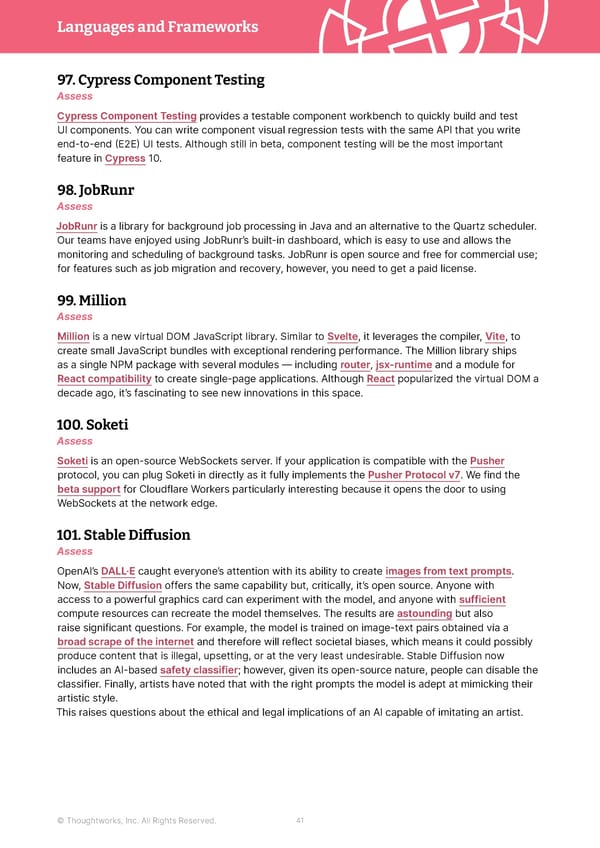Languages and Frameworks Thoughtworks Technology Radar 97. Cypress Component Testing Assess Cypress Component Testing provides a testable component workbench to quickly build and test UI components. You can write component visual regression tests with the same API that you write end-to-end (E2E) UI tests. Although still in beta, component testing will be the most important feature in Cypress 10. 98. JobRunr Assess JobRunr is a library for background job processing in Java and an alternative to the Quartz scheduler. Our teams have enjoyed using JobRunr’s built-in dashboard, which is easy to use and allows the monitoring and scheduling of background tasks. JobRunr is open source and free for commercial use; for features such as job migration and recovery, however, you need to get a paid license. 99. Million Assess Million is a new virtual DOM JavaScript library. Similar to Svelte, it leverages the compiler, Vite, to create small JavaScript bundles with exceptional rendering performance. The Million library ships as a single NPM package with several modules — including router, jsx-runtime and a module for React compatibility to create single-page applications. Although React popularized the virtual DOM a decade ago, it’s fascinating to see new innovations in this space. 100. Soketi Assess Soketi is an open-source WebSockets server. If your application is compatible with the Pusher protocol, you can plug Soketi in directly as it fully implements the Pusher Protocol v7. We find the beta support for Cloudflare Workers particularly interesting because it opens the door to using WebSockets at the network edge. 101. Stable Di昀昀usion Assess OpenAI’s DALL·E caught everyone’s attention with its ability to create images from text prompts. Now, Stable Diffusion offers the same capability but, critically, it’s open source. Anyone with access to a powerful graphics card can experiment with the model, and anyone with sufficient compute resources can recreate the model themselves. The results are astounding but also raise significant questions. For example, the model is trained on image-text pairs obtained via a broad scrape of the internet and therefore will reflect societal biases, which means it could possibly produce content that is illegal, upsetting, or at the very least undesirable. Stable Diffusion now includes an AI-based safety classifier; however, given its open-source nature, people can disable the classifier. Finally, artists have noted that with the right prompts the model is adept at mimicking their artistic style. This raises questions about the ethical and legal implications of an AI capable of imitating an artist. © Thoughtworks, Inc. All Rights Reserved. 41
 Vol 27 | Technology Radar Page 40 Page 42
Vol 27 | Technology Radar Page 40 Page 42